Xue Geng
Exploiting Temporal State Space Sharing for Video Semantic Segmentation
Mar 26, 2025Abstract:Video semantic segmentation (VSS) plays a vital role in understanding the temporal evolution of scenes. Traditional methods often segment videos frame-by-frame or in a short temporal window, leading to limited temporal context, redundant computations, and heavy memory requirements. To this end, we introduce a Temporal Video State Space Sharing (TV3S) architecture to leverage Mamba state space models for temporal feature sharing. Our model features a selective gating mechanism that efficiently propagates relevant information across video frames, eliminating the need for a memory-heavy feature pool. By processing spatial patches independently and incorporating shifted operation, TV3S supports highly parallel computation in both training and inference stages, which reduces the delay in sequential state space processing and improves the scalability for long video sequences. Moreover, TV3S incorporates information from prior frames during inference, achieving long-range temporal coherence and superior adaptability to extended sequences. Evaluations on the VSPW and Cityscapes datasets reveal that our approach outperforms current state-of-the-art methods, establishing a new standard for VSS with consistent results across long video sequences. By achieving a good balance between accuracy and efficiency, TV3S shows a significant advancement in spatiotemporal modeling, paving the way for efficient video analysis. The code is publicly available at https://github.com/Ashesham/TV3S.git.
LPViT: Low-Power Semi-structured Pruning for Vision Transformers
Jul 02, 2024Abstract:Vision transformers have emerged as a promising alternative to convolutional neural networks for various image analysis tasks, offering comparable or superior performance. However, one significant drawback of ViTs is their resource-intensive nature, leading to increased memory footprint, computation complexity, and power consumption. To democratize this high-performance technology and make it more environmentally friendly, it is essential to compress ViT models, reducing their resource requirements while maintaining high performance. In this paper, we introduce a new block-structured pruning to address the resource-intensive issue for ViTs, offering a balanced trade-off between accuracy and hardware acceleration. Unlike unstructured pruning or channel-wise structured pruning, block pruning leverages the block-wise structure of linear layers, resulting in more efficient matrix multiplications. To optimize this pruning scheme, our paper proposes a novel hardware-aware learning objective that simultaneously maximizes speedup and minimizes power consumption during inference, tailored to the block sparsity structure. This objective eliminates the need for empirical look-up tables and focuses solely on reducing parametrized layer connections. Moreover, our paper provides a lightweight algorithm to achieve post-training pruning for ViTs, utilizing second-order Taylor approximation and empirical optimization to solve the proposed hardware-aware objective. Extensive experiments on ImageNet are conducted across various ViT architectures, including DeiT-B and DeiT-S, demonstrating competitive performance with other pruning methods and achieving a remarkable balance between accuracy preservation and power savings. Especially, we achieve up to 3.93x and 1.79x speedups on dedicated hardware and GPUs respectively for DeiT-B, and also observe an inference power reduction by 1.4x on real-world GPUs.
DM3D: Distortion-Minimized Weight Pruning for Lossless 3D Object Detection
Jul 02, 2024



Abstract:Applying deep neural networks to 3D point cloud processing has attracted increasing attention due to its advanced performance in many areas, such as AR/VR, autonomous driving, and robotics. However, as neural network models and 3D point clouds expand in size, it becomes a crucial challenge to reduce the computational and memory overhead to meet latency and energy constraints in real-world applications. Although existing approaches have proposed to reduce both computational cost and memory footprint, most of them only address the spatial redundancy in inputs, i.e. removing the redundancy of background points in 3D data. In this paper, we propose a novel post-training weight pruning scheme for 3D object detection that is (1) orthogonal to all existing point cloud sparsifying methods, which determines redundant parameters in the pretrained model that lead to minimal distortion in both locality and confidence (detection distortion); and (2) a universal plug-and-play pruning framework that works with arbitrary 3D detection model. This framework aims to minimize detection distortion of network output to maximally maintain detection precision, by identifying layer-wise sparsity based on second-order Taylor approximation of the distortion. Albeit utilizing second-order information, we introduced a lightweight scheme to efficiently acquire Hessian information, and subsequently perform dynamic programming to solve the layer-wise sparsity. Extensive experiments on KITTI, Nuscenes and ONCE datasets demonstrate that our approach is able to maintain and even boost the detection precision on pruned model under noticeable computation reduction (FLOPs). Noticeably, we achieve over 3.89x, 3.72x FLOPs reduction on CenterPoint and PVRCNN model, respectively, without mAP decrease, significantly improving the state-of-the-art.
From Algorithm to Hardware: A Survey on Efficient and Safe Deployment of Deep Neural Networks
May 09, 2024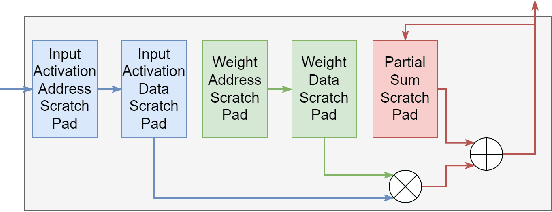
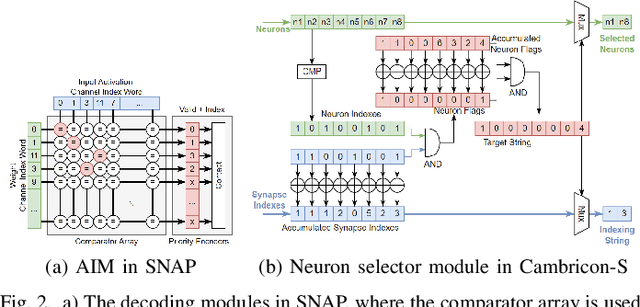
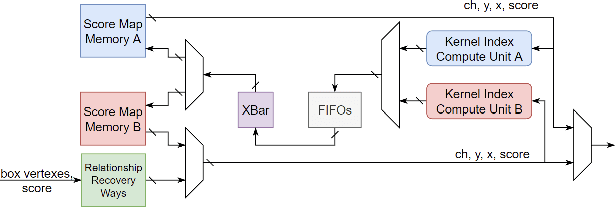
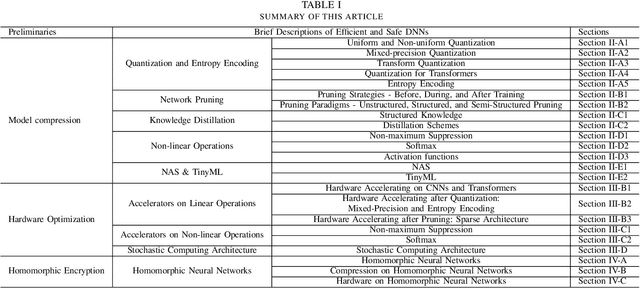
Abstract:Deep neural networks (DNNs) have been widely used in many artificial intelligence (AI) tasks. However, deploying them brings significant challenges due to the huge cost of memory, energy, and computation. To address these challenges, researchers have developed various model compression techniques such as model quantization and model pruning. Recently, there has been a surge in research of compression methods to achieve model efficiency while retaining the performance. Furthermore, more and more works focus on customizing the DNN hardware accelerators to better leverage the model compression techniques. In addition to efficiency, preserving security and privacy is critical for deploying DNNs. However, the vast and diverse body of related works can be overwhelming. This inspires us to conduct a comprehensive survey on recent research toward the goal of high-performance, cost-efficient, and safe deployment of DNNs. Our survey first covers the mainstream model compression techniques such as model quantization, model pruning, knowledge distillation, and optimizations of non-linear operations. We then introduce recent advances in designing hardware accelerators that can adapt to efficient model compression approaches. Additionally, we discuss how homomorphic encryption can be integrated to secure DNN deployment. Finally, we discuss several issues, such as hardware evaluation, generalization, and integration of various compression approaches. Overall, we aim to provide a big picture of efficient DNNs, from algorithm to hardware accelerators and security perspectives.
Efficient Joint Optimization of Layer-Adaptive Weight Pruning in Deep Neural Networks
Aug 24, 2023Abstract:In this paper, we propose a novel layer-adaptive weight-pruning approach for Deep Neural Networks (DNNs) that addresses the challenge of optimizing the output distortion minimization while adhering to a target pruning ratio constraint. Our approach takes into account the collective influence of all layers to design a layer-adaptive pruning scheme. We discover and utilize a very important additivity property of output distortion caused by pruning weights on multiple layers. This property enables us to formulate the pruning as a combinatorial optimization problem and efficiently solve it through dynamic programming. By decomposing the problem into sub-problems, we achieve linear time complexity, making our optimization algorithm fast and feasible to run on CPUs. Our extensive experiments demonstrate the superiority of our approach over existing methods on the ImageNet and CIFAR-10 datasets. On CIFAR-10, our method achieves remarkable improvements, outperforming others by up to 1.0% for ResNet-32, 0.5% for VGG-16, and 0.7% for DenseNet-121 in terms of top-1 accuracy. On ImageNet, we achieve up to 4.7% and 4.6% higher top-1 accuracy compared to other methods for VGG-16 and ResNet-50, respectively. These results highlight the effectiveness and practicality of our approach for enhancing DNN performance through layer-adaptive weight pruning. Code will be available on https://github.com/Akimoto-Cris/RD_VIT_PRUNE.
CRAFT: Cross-Attentional Flow Transformer for Robust Optical Flow
Mar 31, 2022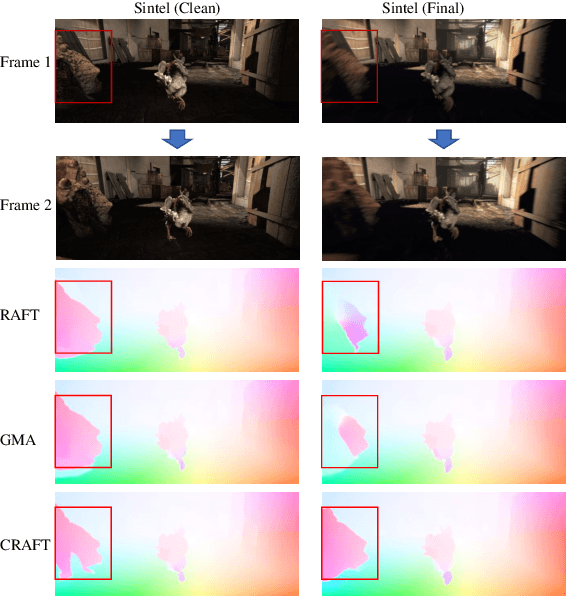
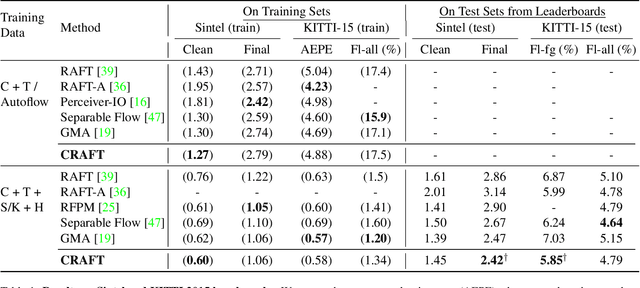
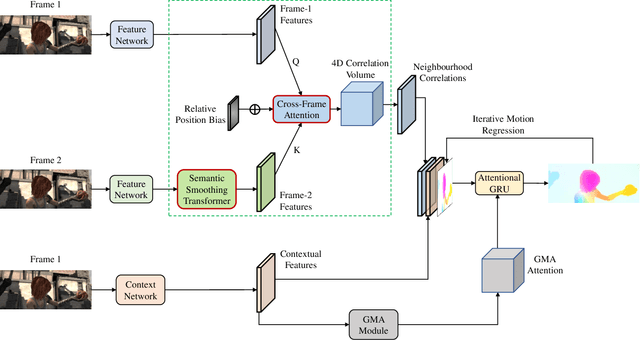
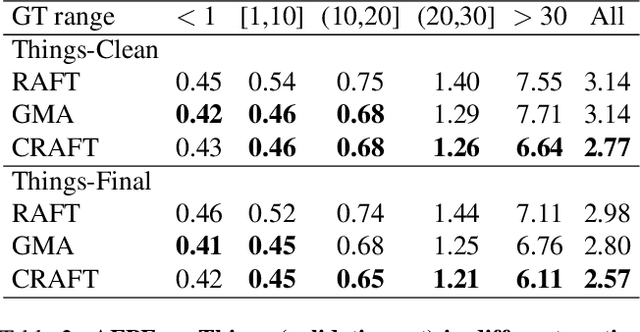
Abstract:Optical flow estimation aims to find the 2D motion field by identifying corresponding pixels between two images. Despite the tremendous progress of deep learning-based optical flow methods, it remains a challenge to accurately estimate large displacements with motion blur. This is mainly because the correlation volume, the basis of pixel matching, is computed as the dot product of the convolutional features of the two images. The locality of convolutional features makes the computed correlations susceptible to various noises. On large displacements with motion blur, noisy correlations could cause severe errors in the estimated flow. To overcome this challenge, we propose a new architecture "CRoss-Attentional Flow Transformer" (CRAFT), aiming to revitalize the correlation volume computation. In CRAFT, a Semantic Smoothing Transformer layer transforms the features of one frame, making them more global and semantically stable. In addition, the dot-product correlations are replaced with transformer Cross-Frame Attention. This layer filters out feature noises through the Query and Key projections, and computes more accurate correlations. On Sintel (Final) and KITTI (foreground) benchmarks, CRAFT has achieved new state-of-the-art performance. Moreover, to test the robustness of different models on large motions, we designed an image shifting attack that shifts input images to generate large artificial motions. Under this attack, CRAFT performs much more robustly than two representative methods, RAFT and GMA. The code of CRAFT is is available at https://github.com/askerlee/craft.
Role-Wise Data Augmentation for Knowledge Distillation
Apr 19, 2020

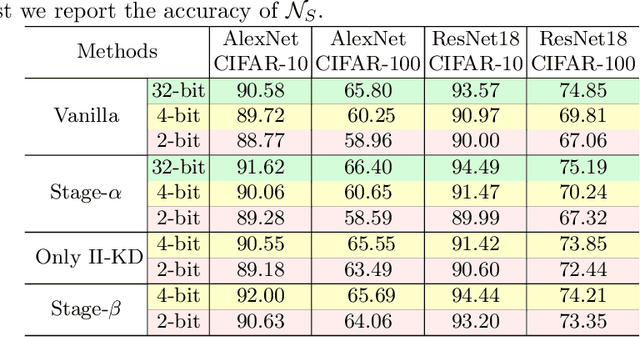

Abstract:Knowledge Distillation (KD) is a common method for transferring the ``knowledge'' learned by one machine learning model (the \textit{teacher}) into another model (the \textit{student}), where typically, the teacher has a greater capacity (e.g., more parameters or higher bit-widths). To our knowledge, existing methods overlook the fact that although the student absorbs extra knowledge from the teacher, both models share the same input data -- and this data is the only medium by which the teacher's knowledge can be demonstrated. Due to the difference in model capacities, the student may not benefit fully from the same data points on which the teacher is trained. On the other hand, a human teacher may demonstrate a piece of knowledge with individualized examples adapted to a particular student, for instance, in terms of her cultural background and interests. Inspired by this behavior, we design data augmentation agents with distinct roles to facilitate knowledge distillation. Our data augmentation agents generate distinct training data for the teacher and student, respectively. We find empirically that specially tailored data points enable the teacher's knowledge to be demonstrated more effectively to the student. We compare our approach with existing KD methods on training popular neural architectures and demonstrate that role-wise data augmentation improves the effectiveness of KD over strong prior approaches. The code for reproducing our results can be found at https://github.com/bigaidream-projects/role-kd
Dataflow-based Joint Quantization of Weights and Activations for Deep Neural Networks
Jan 04, 2019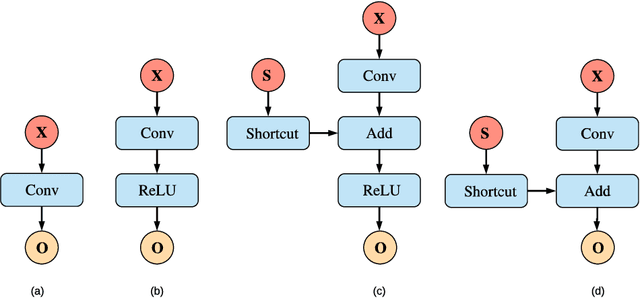



Abstract:This paper addresses a challenging problem - how to reduce energy consumption without incurring performance drop when deploying deep neural networks (DNNs) at the inference stage. In order to alleviate the computation and storage burdens, we propose a novel dataflow-based joint quantization approach with the hypothesis that a fewer number of quantization operations would incur less information loss and thus improve the final performance. It first introduces a quantization scheme with efficient bit-shifting and rounding operations to represent network parameters and activations in low precision. Then it restructures the network architectures to form unified modules for optimization on the quantized model. Extensive experiments on ImageNet and KITTI validate the effectiveness of our model, demonstrating that state-of-the-art results for various tasks can be achieved by this quantized model. Besides, we designed and synthesized an RTL model to measure the hardware costs among various quantization methods. For each quantization operation, it reduces area cost by about 15 times and energy consumption by about 9 times, compared to a strong baseline.
 Add to Chrome
Add to Chrome Add to Firefox
Add to Firefox Add to Edge
Add to Edge